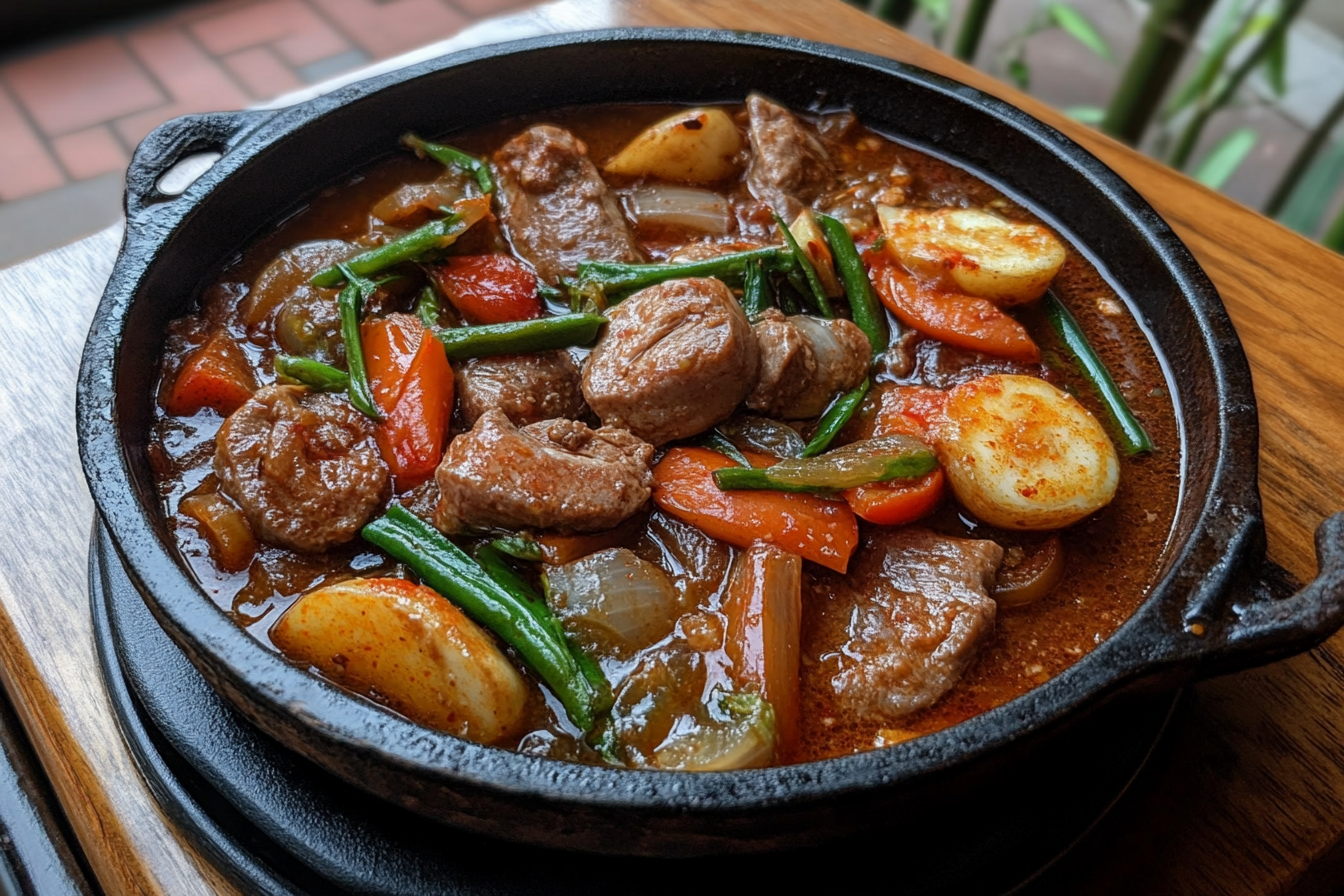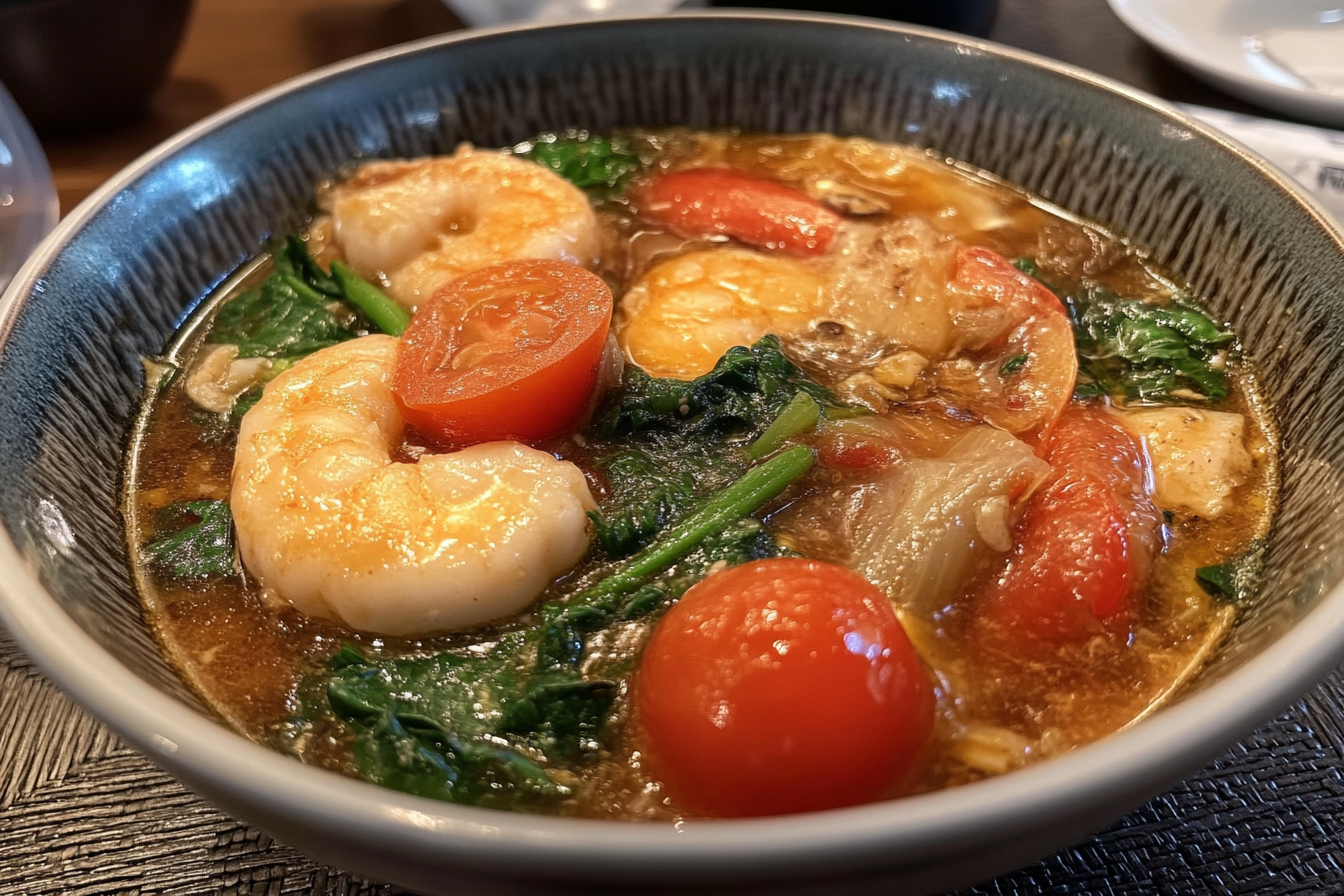Sinigang is a Filipino dish known for its tangy, savory flavor, typically made with a variety of proteins and a medley of fresh vegetables. What sets sinigang apart is its distinct sourness, derived from tamarind and other fruits. This Filipino staple offers not only a delicious culinary experience but also a deep connection to Filipino culture and heritage. Let’s explore everything there is to know about sinigang, from its key ingredients to regional variations, nutritional benefits, and how to make the perfect bowl at home.
Introduction to Sinigang
Sinigang is a traditional Filipino soup or stew known for its sour broth. It’s commonly made with shrimp, fish, or chicken, and vegetables such as eggplant, string beans, tomatoes, kangkong (water spinach), and okra. The dish is loved for its tangy taste, usually attributed to tamarind (sampalok), though other fruits like guava and kamias can also be used as souring agents.
The cultural significance of sinigangs in the Philippines is immense. It’s more than just a dish; it’s a symbol of comfort, a meal that brings family and friends together. Every spoonful of this soup embodies the warmth of Filipino hospitality.
Historical and Cultural Significance of Sinigang
While sinigang has evolved over time, it remains a quintessential Filipino dish with roots that date back centuries. Unlike many other Filipino dishes influenced by foreign cuisines, sinigangs is uniquely Filipino. Its use of indigenous ingredients such as tamarind, local fish, and fresh vegetables reflects the agricultural richness of the Philippines.
The dish is enjoyed throughout the country, with slight variations depending on regional ingredients. For example, in coastal areas, fish sinigang or shrimp sinigangs is more common, while inland provinces may opt for chicken or other readily available meats.
Sinigang is also central to Filipino celebrations, often served at large gatherings like family reunions, birthdays, and fiestas. Its simple preparation allows home cooks to personalize the dish, adapting it based on the available produce and individual taste preferences. Explore other hearty Filipino recipes that represent the country’s culinary diversity if you’re interested in more traditional Filipino dishes for gatherings.
Core Ingredients of Sinigang
At the heart of sinigang is its balance of sourness and savoriness. The core ingredients are easy to find, yet the combination creates a deeply flavorful and satisfying dish. Here’s a breakdown of the key components that make sinigang so unique.
Protein
Sinigang is versatile when it comes to protein, which can include:
- Shrimp: A lighter option, sinigang na hipon is popular for its fresh, seafood flavor.
- Fish: Sinigang na isda is often made with bangus (milkfish), tilapia, or pompano. Fish provides a delicate taste that pairs well with the sour broth.
- Chicken: In sinigang na manok, chicken adds a hearty flavor without overpowering the tanginess of the broth.
Souring Agents
The sourness in sinigang defines the dish. The most common souring agents include:
- Tamarind (sampalok): Tamarind is the traditional and most widely used souring agent in sinigang. It can be added fresh, in paste form, or as a tamarind soup mix.
- Guava (bayabas): This adds a milder, sweeter sourness to the soup, resulting in a less tangy broth.
- Kamias: Known for its strong sour flavor, kamias is another alternative, especially in regions where tamarind is not readily available.
- Calamansi: This small, citrus fruit gives a bright, fresh sourness to the dish.
Vegetables
The vegetables in sinigang provide both flavor and nutrition:
- Tomatoes: Tomatoes add acidity and sweetness to the broth.
- String Beans (sitaw): These long, green beans offer a crunchy texture.
- Eggplant (talong): Eggplant absorbs the broth and adds a soft texture.
- Okra: This vegetable brings a slightly slimy texture, which some people love for its ability to thicken the broth.
- Kangkong: Water spinach is a must for its leafy, earthy taste.
These vegetables not only enhance the flavor but also pack the dish with essential vitamins and minerals, making it a nutritious meal.
The Importance of Tamarind in Sinigang
Tamarind is often the first ingredient that comes to mind when people think of sinigangs. The fruit’s pulp adds the sourness that defines the dish. Tamarind can be used fresh, in paste form, or as part of a pre-made sinigang mix. Each form offers a slightly different flavor profile, but all contribute to the dish’s signature tangy taste.
The nutritional benefits of tamarind are also significant. It’s rich in antioxidants, which help fight free radicals in the body, and it contains vital nutrients such as magnesium, potassium, and fiber. Discover more about the health benefits of tamarind and its role in various dishes.
How to Make the Perfect Sinigang
The beauty of sinigang lies in its simplicity. While the ingredients are basic, mastering the balance between sour, salty, and savory flavors is key. Here’s a step-by-step guide to making a delicious bowl of sinigang:
Ingredients:
- Protein: 500g shrimp, fish, or chicken.
- Tamarind: 100g fresh tamarind or 2 tbsp tamarind paste.
- Vegetables: 2 tomatoes, 1 onion, 5 pieces of okra, 1 cup of kangkong, 1 cup of sitaw, and 1 eggplant.
- Seasoning: 2 tbsp fish sauce, salt, and pepper to taste.
Instructions:
- Boil the Tamarind: If using fresh tamarind, boil it until soft, then strain the juice. This will serve as the base of your broth.
- Cook the Protein: Add the shrimp, fish, or chicken to the tamarind broth and let it simmer until cooked through. For shrimp, this takes about 5-7 minutes, while fish and chicken will take longer.
- Add the Vegetables: Start by adding the tomatoes and onions. Let them soften, then follow with the harder vegetables like eggplant and sitaw. Finally, add the kangkong and okra.
- Season: Adjust the taste with fish sauce, salt, and pepper. The balance of flavors should be tangy from the tamarind, with a hint of saltiness from the fish sauce.
- Serve: Serve the soup hot with steamed rice.
For more variations of this dish and other Filipino comfort foods, check out this guide to Filipino recipes.
Nutritional Benefits of Sinigang
Sinigang is not only a flavorful dish but also packed with health benefits. The combination of fresh vegetables, lean proteins, and tamarind makes it a well-rounded meal. Here are some of its key nutritional benefits:
- High in Fiber: The vegetables in sinigang, such as okra and kangkong, are rich in fiber, which aids digestion and supports heart health.
- Low in Fat: Using lean proteins like shrimp, fish, or chicken ensures that sinigangs remains low in fat, making it a heart-healthy option.
- Rich in Antioxidants: Tamarind and tomatoes provide antioxidants that help reduce inflammation and lower the risk of chronic diseases.
- Packed with Vitamins: The variety of vegetables in sinigang provides a wealth of vitamins and minerals, including vitamin A from kangkong, vitamin C from tomatoes, and potassium from sitaw.
In addition to its health benefits, sinigang is a dish that can be tailored to suit dietary needs. Those following low-sodium diets can reduce the amount of fish sauce or opt for alternatives like low-sodium soy sauce.
Regional Variations of Sinigang
Across the Philippines, different regions put their own spin on sinigang. While the core elements remain the same, the use of local ingredients gives each version a unique flavor:
Sinigang na Hipon
This seafood version uses shrimp as the primary protein. It’s often lighter and quicker to prepare than other varieties. The sweetness of the shrimp pairs beautifully with the tanginess of the broth.
Sinigang na Isda
Fish, particularly bangus (milkfish) or tilapia, is the protein of choice for sinigangs na isda. Coastal regions tend to favor this version due to the abundance of fresh fish. The delicate fish flavor complements the broth’s sourness, creating a more subtle yet flavorful dish.
Sinigang na Manok
Chicken sinigang is less common but equally delicious. The chicken adds a rich flavor to the broth, making it heartier. It’s a great alternative for those who prefer a less tangy soup, as the chicken’s flavor mellows the sourness.
Sinigang sa Bayabas
Instead of tamarind, guava is used as the souring agent in this version. The result is a sweeter, more fragrant broth that balances the richness of the meat. Sinigang sa bayabas is often made with chicken or fish.
If you’re curious about exploring even more regional dishes, this Filipino recipe collection has a variety of options to try.
Modern and Fusion Twists on Sinigang
Sinigang has evolved with modern culinary trends, leading to creative twists on the traditional recipe. These variations offer a fun way to enjoy the classic dish while introducing new flavors and textures:
Sinigang Ramen
Sinigang Ramen, a popular fusion dish, pairs the tangy sinigang broth with ramen noodles. This blend of Filipino and Japanese cuisine offers a new way to experience the dish, especially for noodle lovers.
Sinigang with Fruits
Some chefs and home cooks experiment with adding fruits like pineapple or mango to sinigangs. These fruits add a sweet contrast to the sour broth, creating a more complex flavor profile.
Common Mistakes to Avoid When Making Sinigang
While sinigang is relatively easy to prepare, there are a few common mistakes that can affect the final dish. Here are some tips to avoid them:
- Overcooking the Vegetables: Add vegetables like okra and kangkong towards the end to retain their texture. Overcooking them can make the soup mushy.
- Not Balancing the Sourness: It’s easy to overdo the sourness. Always taste as you go and add souring agents gradually until you reach the desired balance.
- Using Too Much Salt: Fish sauce is naturally salty, so be cautious when adding additional salt. You can always add more later, but it’s harder to fix an overly salty broth.
Frequently Asked Questions (FAQs)
What is the best protein for Sinigang?
- Shrimp, fish, and chicken are all excellent choices, depending on your personal preference. Shrimp offers a light, sweet flavor, while chicken and fish provide a heartier taste.
Can I make Sinigang without tamarind?
- Yes, you can substitute tamarind with other souring agents like guava, calamansi, or kamias.
How do I store leftover Sinigang?
- Leftover sinigang can be stored in an airtight container in the refrigerator for up to 3 days. Reheat it on the stove for the best flavor.
Conclusion
Sinigang is a dish that transcends time and geography, offering a flavorful, healthy, and comforting meal that is deeply rooted in Filipino culture. Whether you prefer it with shrimp, fish, or chicken, this tangy soup is a testament to the rich culinary heritage of the Philippines. Try your hand at making it at home, and don’t be afraid to experiment with different proteins, souring agents, and vegetables.
With a dish as versatile as sinigangs, the possibilities are endless. Enjoy the process, savor the flavors, and most importantly, share it with those you love.



